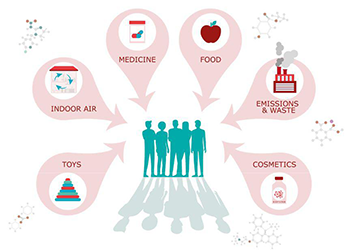
Humans and wildlife are exposed to an infinite number of different combinations of chemicals, via food, consumer products and the environment. Combined exposure to multiple chemicals can lead to unacceptable effects, even if single substances in the mixtures are below their individual safety thresholds.
The assessment and management of chemical mixtures is only partly covered by current legislation, which focuses on single substances in isolated sectors.
In particular, while formulated products are covered, unintentional mixtures are not consistently addressed. Their composition is often unknown and changes over time, making them difficult to regulate. The assessment of unintentional mixtures is therefore usually limited to specific legislative sectors, such as pesticide residues in food.
How to assess mixtures?
Mixture risks are assessed either by testing the whole mixture (e.g. in effect-based monitoring of surface water) or by predicting the combined risk based on concentration and effect information of the individual components in the mixture (e.g. in the assessment of dioxins and dioxin-like compounds in food and feed).
Several international frameworks are available for the assessment of chemical mixtures, e.g. from WHO/IPCS.
However, there are major knowledge gaps hampering their application. The EC Communication on Combined effects of chemicals – chemical mixtures (2012) called for an improved understanding of the exposure to chemical mixtures, the toxic effects, modes of action and potential interactions of chemicals, as well as the identification of specific mixtures to be addressed with priority.
Specific challenges
Combined exposure: Unravelling the composition of unintentional mixtures remains difficult. Neglecting relevant mixture constituents can lead to an underestimation of risks. However, chemical monitoring data are scarce, although becoming more consistently available via the EC platform IPCHEM. Moreover, chemical analyses only measure the chemicals expected to be present. Another challenge is to take into account sequential exposures at different moments in time.
Biomonitoring chemical concentrations in wildlife or humans is a means to identify realistic co-exposure. Modelling tools for exposure assessment need to be further developed.
Combined effects: It is not feasible to test all possible mixtures experimentally, considering the large number of potential chemical combinations. On the other hand, prediction of mixture effects based on the individual chemicals is often limited by lack of knowledge of their toxicity and toxic modes of action. Therefore, smart strategies and more efficient tools are needed, relying less on in vivo testing and instead on alternative experimental and computational tools.
Combined risks: Managing the risks from exposure to chemical mixtures presents a policy challenge. Each individual chemical might be at a safe level of exposure, but the combination of chemicals may pose a risk. Even if chemicals within a legislative sector are addressed as mixtures, combined effects from chemicals regulated under different sectors might occur. Thus, risk management decisions may need to be taken on which chemicals or sources should be subject to restrictions. To cope with the large number of possible mixtures, priority mixtures of particular concern should be identified, as well as the individual chemicals driving their risk.
JRC activities on mixtures
JRC, the Joint Research Centre of the European Commission, is performing research on the use of alternative (non-animal) methods and new strategies to assess the combination effects of chemicals. Having reviewed current EU regulatory requirements and mixture assessment practices, JRC is currently exploring links between mixtures and diseases, interaction effects of chemicals, as well as the use of biomonitoring data in exposure assessment.
JRC collaborates with five EU funded research consortia focusing on chemical mixture assessment for the environment (SOLUTIONS), human health (EuroMix, HBM4EU), endocrine disruption (EDCMixRisk) and alternatives to animal testing (EUToxRisk).
JRC also facilitates and provides scientific input to discussions with EU regulators from
European Commission DGs and agencies. Furthermore, JRC is actively involved in
international initiatives under the auspices of the OECD and the WHO.
Print this page
